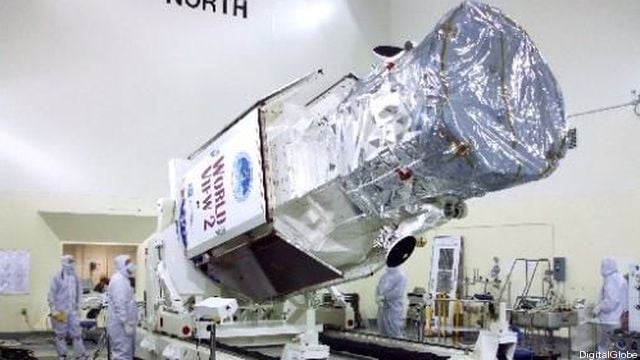DigitalGlobe, Eager for Foreign Biz, Presses NOAA For Quarter Meter Resolution
Posted on
 WASHINGTON: In the next few weeks an unlikely government agency known more for weather than regulating satellites, the National Oceanic and Atmospheric Agency (NOAA), may decide the international future of America’s commercial satellite imagery industry, dominated now by DigitalGlobe.
WASHINGTON: In the next few weeks an unlikely government agency known more for weather than regulating satellites, the National Oceanic and Atmospheric Agency (NOAA), may decide the international future of America’s commercial satellite imagery industry, dominated now by DigitalGlobe.
NOAA licenses American commercial remote sensing satellites, which includes DigitalGlobe’s five satellites currently in orbit. One of the key restrictions these licenses impose on what some call the commercial spy satellite company is how much detail — resolution — their satellite pictures can offer to commercial clients. Currently, the resolution limit is half a meter. although I understand the GeoEye and DigitalGlobe birds will be able to supply photos with resolution as low as 10 centimeters to government clients such as the National Geospatial Intelligence Agency. The lowest current official resolution is 41 centimeters, although I understand the next GeoEye and DigitalGlobe birds will be able to supply photos with significantly lower resolutions to government clients such as the National Geospatial Intelligence Agency. So if DigitialGlobe has an image at a higher resolution it actually has to make it blurrier before it can sell the image. CLARIFIED RESOLUTIONS AVAILABLE Aug. 26 at 10:30 a.m.
But Walter Scott, DigitalGlobe’s founder and now executive VP and chief technical officer, tells me there is “significant demand” for quarter-meter resolution from the international market. And that’s why the company applied for a change to the resolution they can be licensed for from half a meter to a quarter meter.
And DigitalGlobe is “optimistic” that NOAA will change the resolution. There are afew reasons for the possiblity of a change. Airplane cameras can yield resolution of one inch and satellite optics and their related technologies have improved markedly over the decade since the license standards were put in place, NOAA may well conclude that their current restriction hamstrings American businesses in their attempts to penetrate the international market. As many in the defense industry have argued — and quite a few intelligence professionals — it’s much better for the United States to sell sensitive technology to friendly governments because we both ensure market share and we know with great detail the technical capabilities our friends and allies rely on.
Scott points to the recent sale to the Abu Dhabi by France of two electro-optical satellite, where Lockheed Martin lost the 700 million Euro competition, as a sign of the increasing strength of international competition. DigitalGlobe had been contacted about selling GeoEye 2, a satellite otherwise consigned to years in a warehouse since DigitialGlobe absorbed GeoEye early this year, to Abu Dhabi. It’s unclear whether the resolution restrictions played any role in Abu Dhabi’s decision to go with the French satellite. Also, the French reportedly offered access to services, including image processing software, expert training and other services as part of the deal.
But the Falcon Eye deal, as it’s known, is clearly an arrow in Digital Globe’s quiver as it presses its case with the US government.
Part of the reason DigitalGlobe is so eager to boost foreign sales by making its satellites more technically appealing through the resolution change is that overall spending on commercial imagery by their biggest single client — the United States government — is likely to come down over the next few years as the war in Afghanistan winds down. Diretor of National Intelligence James Clapper has called for double digit cuts to the intelligence budget over the next decade and he made clear that a substantial portion of those cuts would come from the pots of money spent on commercial imagery.
But Scott notes that DigitalGlobe has seen some of its business with the government– value-added analytic work — increase since the merger with GeoEye. Also, the Pentagon’s pivot to the Pacific provides a potentially huge market for Scott’s company. The enormous expanses of the Pacific, combined with the need for constantly updated imagery to provide the intelligence community with data for change detection analysis and other intelligence, he argues.
Subscribe to our newsletter
Promotions, new products and sales. Directly to your inbox.
